#tsarina catherine i
Text

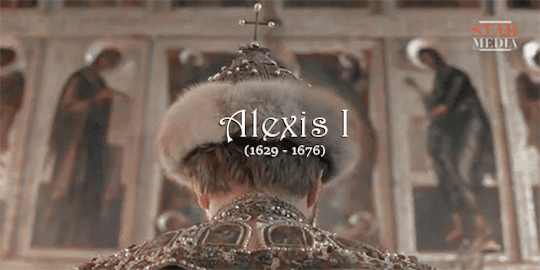


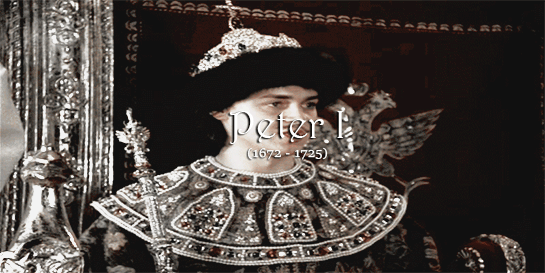
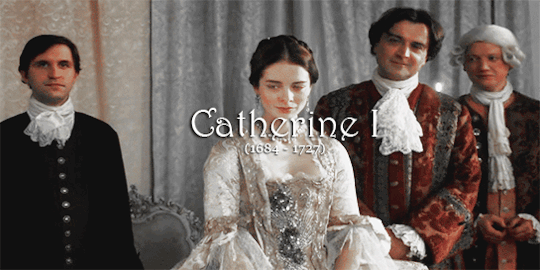
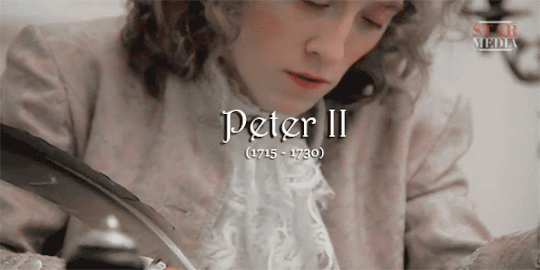

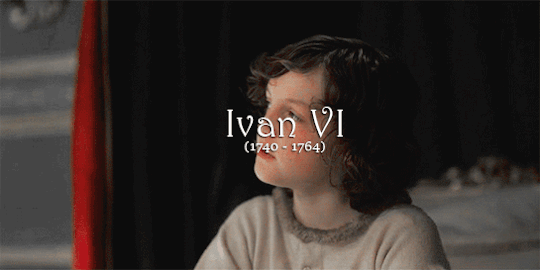


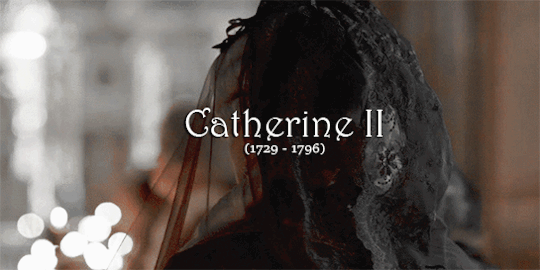
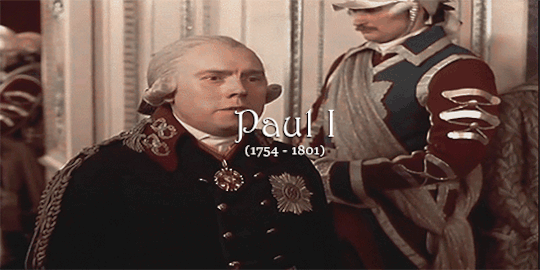

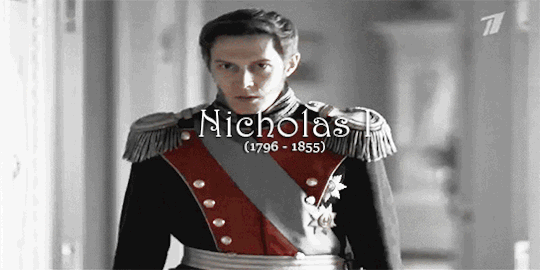


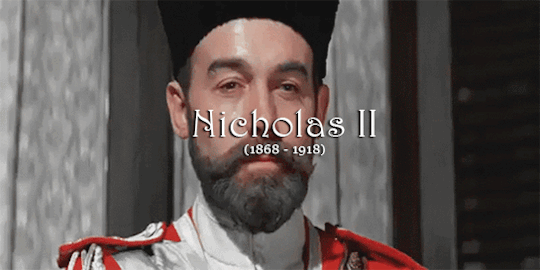
"Over the centuries, the Empire has grown in size and in the number of conquered peoples. It once possessed an area equivalent to one-sixth of the globe, stretching from the Pacific to the German border, on which the sun never set and which was ruled by an autocrat Tsar who owed satisfaction only to God."
The last tsars - a brief untold history about the Romanovs | Paulo Rezzutti.
(Loose translation)
#tsar#tsarina#facts#romanovs#russian history#the romanovs 2013#tsar michael i#tsar alexei i#tsar nicholas ii#catherine the great#tsar paul i#tsar peter ii#tsar peter iii#peter the great#tsarina elizabeth#tsarina catherine i#tsar alexander ii#tsar alexander iii#tsar alexander i#tsar nicholas i#tsar ivan v#tsar ivan vi#tsarina anna#tsarina anna i#tsarina elizabeth i#nicholas and alexandra 1971#zvezda imperii 2008#poor poor paul#roman imperatora 1994#delo dekabristov
192 notes
·
View notes
Text
anyway, Pope Francis is dumb as hell, he praises Russia's anti-Catholic, barbaric history.
russians: persecute catholics and destroy their country (e.g. after they invaded poland, they closed many roman catholic churches and turned them into orthodox churches, they did not allow people to build catholic churches, they persecuted priests, they hanged many priests who were against russian occupation, Tsarina Catherine personally forbade any contact with Rome, Nicholas I closed many monasteries, churches in poland (1832), he stole their property (1842), he sent many priests to forced labour, e.g. they sent many to Siberia for hard labor, + they especially hated and persecuted greek catholics/byzantine rite catholics)
Pope Francis: what a wonderful legacy 😍
.
.
.
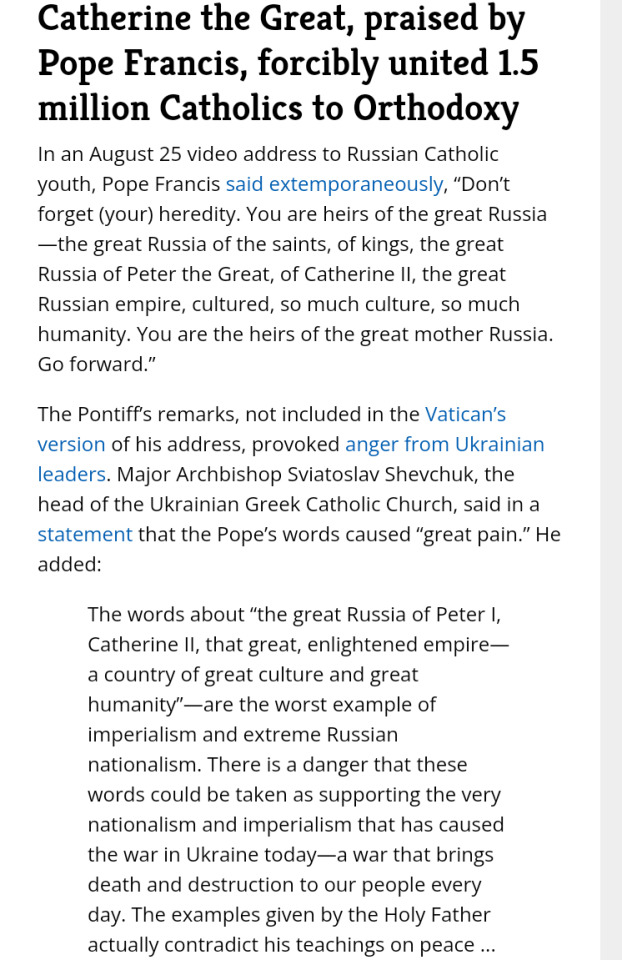
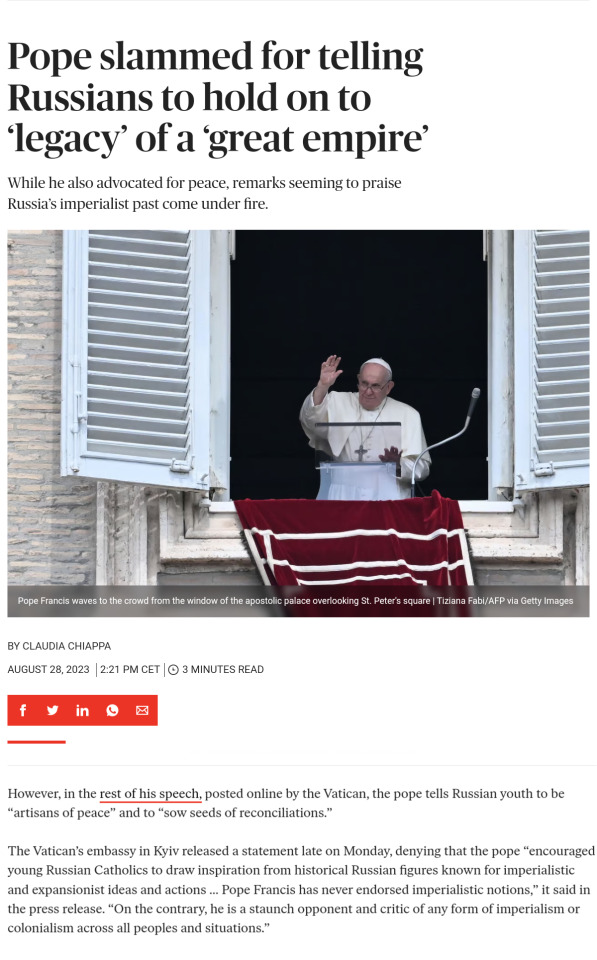
🤡...
#pope francis#anti imperialism#anti colonialism#christianity#roman catholic#politics#vatican#catholic#catholicism#poland#catherine the great#greek catholic#catherine ii#imperial russia#leftblr#roman catholicism#stand with ukraine#russian imperialism#russian war on ukraine#byzantine catholic
220 notes
·
View notes
Text
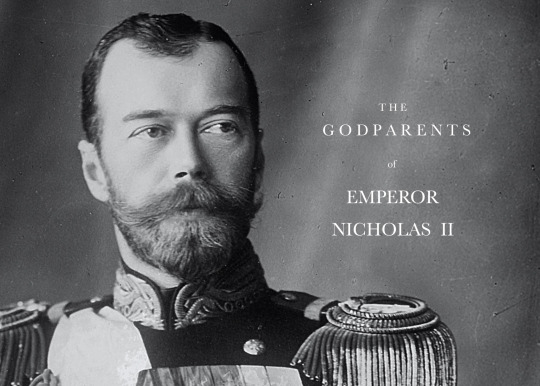


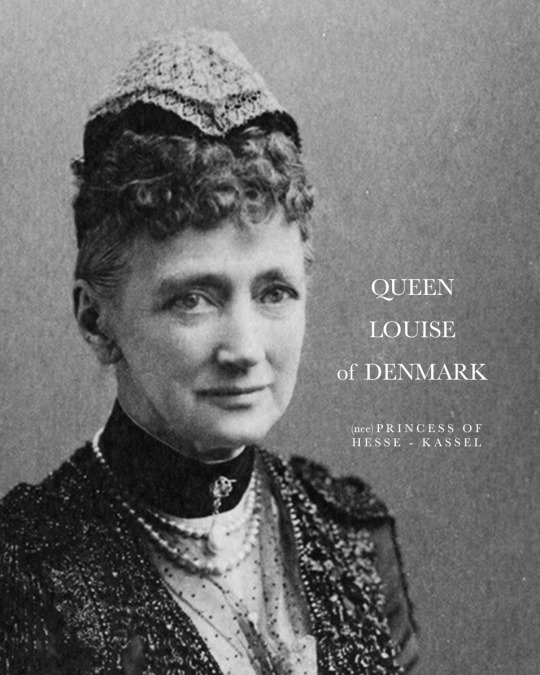

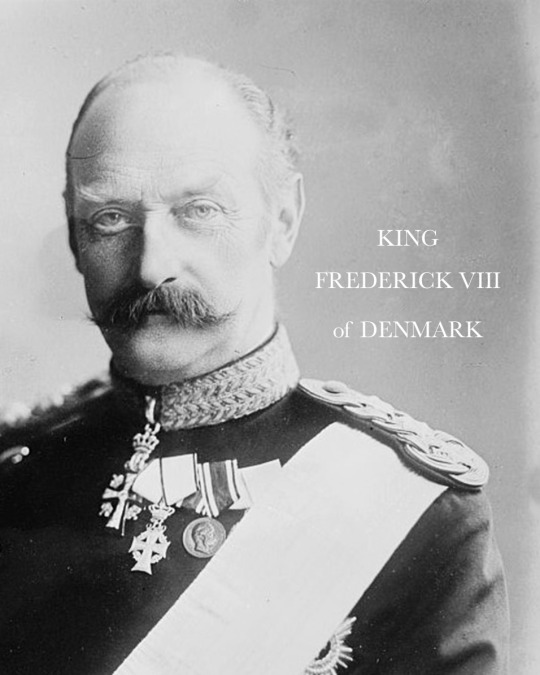
GODPARENTS OF NICHOLAS II
Born during his grandfather's reign on 18 May (New Style) 1868 at the Alexander Palace, Tsarkoe Selo in Saint Petersburg. He was the eldest son of Alexander III and his wife Maria Feodorovna (then, the Tsarevich and Tsarina of Russia). He was christened on 1 June at the Chapel of the Resurrection of the Catherine Palace at Tsarskoe Selo, by the confessor of the imperial family, protopresbyter Vasily Borisovich Bazhanov. His godparents were:
ALEXANDER II, EMPEROR OF RUSSIA - his paternal grandfather, the Russian Emperor stood as one of the godparents. He became the Emperor of All Russia in 1855. Alexander’s most significant reform as emperor was the emancipation of Russia’s serfs in 1861, for which he is known as Alexander the Liberator. He was assassinated in 1881 when the young Nicholas was only 12 years-old, to which he became the heir apparent upon his death.
PRINCESS MARIE OF HESSE AND BY RHINE, EMPRESS MARIA ALEXANDROVNA OF RUSSIA - his paternal grandmother, the consort of Emperor Alexander II, was another of his godparents. Known for her intellect, she was one of the founders of the Russian Red Cross Society. However, she suffered from tuberculosis from 1863 and spent long stays in southern Europe to avoid harsh winters. Although she and her husband were unofficially separated sometime after the death of their eldest son, Maria was treated with respect and love by her surviving family. Maria passed away from illness when the young Nicholas was still a child.
PRINCESS LOUISE OF HESSE-KASSEL, QUEEN CONSORT OF DENMARK - his maternal grandmother was listed as one of his godparents. Louise became the Queen consort of Denmark upon her husband's - King Christian IX - accession in 1863, just few years before her grandson Nicholas' birth. She, herself, was a niece of another King of Denmark (Christian VIII). The great dynastic success of Louise's six children was to a great extent a result of Louise's own ambitions - through them, she was a grandmother of not only the future Tsar of Russia (Nicholas II), but also that of King George V of the United Kingdom; King Constantine I of Greece; King Christian X of Denmark, and King Harken VII of Norway.
GRAND DUCHESS ELENA PAVLOVNA OF RUSSIA - his great-great-aunt, the wife of the late Grand Duke Michael Pavlovich, was one of his godparents. Born as Princess Charlotte of Württemberg, she became a close friend of his grandmother the Empress Maria Alexandrovna, and was known as an intellectual. She was also considered the most exceptional woman in the imperial family since Catherine the Great.
KING FREDERICK VIII OF DENMARK - then, the Crown Prince, his maternal uncle stood as one of his godparents. During the long reign of his father, he was largely excluded from influence and political power. Upon his father's death in 1906, he acceded to the throne at the advanced age of 62. In many ways, Frederick VIII was a liberal monarch who was much more favorable to the new parliamentary system introduced in 1901 than his father had been, being reform-minded and democratically inclined.
Source
84 notes
·
View notes
Note
Greetings, Duchess. Were there kingdoms that didn't care whether a royal marries a commoner? What was so special about the case of Peter the Great and Catherine I? How did she succeed her husband as empress?
Yes and no. No country outwardly accepted these marriages like some do to today, but the level of pushback varied from minor ridicule to assassination.
Because Catherine was a laundress, not even a high-ranking servant.
Because Peter decreed so and for a while when the Tsar died, the Tsarina could take power
12 notes
·
View notes
Text
When Russians weren't looting washing machines, toilets, and used underwear from Ukraine in the early weeks of the invasion, they were looting museums.
As a result of the Ukrainian counter-offensive in the summer of 2022, the Russian army was forced to withdraw from the area around Kherson. On November 11, the city was liberated by the Ukrainian army.
One of the many consequences of the Russian invasion of Ukraine and the months of turbulence in the Kherson region has been the devastation of the cultural sector.
For example, at the beginning of November 2022, entire collections were removed from the Kherson Art Museum, the Kherson Regional Museum and the Kherson Region National Archives. Tombstones of Russian Tsarist commanders and even the remains of Russian Field Marshal Grigory Potemkin, a confidant of Tsarina Catherine II (Empress Catherine the Great), were looted.
Yep, Putin's troops (I use troops loosely) even took the bones of Grigory Potemkin of "Potemkin village" fame.
The Kherson Regional Museum director, Olga Goncharova, laments the loss of the most valuable collection items. The Russians took ancient Greek amphorae, gold ornaments from steppe nomads, medieval weapons and Orthodox icons to the left bank of the Dnipro River, an area still occupied by Russia.
Goncharova says that since the occupying forces withdrew, the museum has also lacked important lists of exhibits and documents proving their historical value. She can therefore only roughly estimate the number of looted objects at around 23,000.
Putin is attempting to eradicate even the idea of Ukraine. That's part of the definition of genocide.
During the Russian invasion, more than 40 museums in the occupied territories were looted, says Ukraine's first deputy prosecutor general, Oleksiy Khomenko. The loss has not yet been fully quantified. "It could take years," he says.
By the end of the year, the Ukrainian Ministry of Culture and Information Policy intends to create a register in which all available information on collections located in the occupied territories will be entered. This should later help to find art and valuables. However, this will probably only be possible after the end of the war.
For anybody who"s interested, here's the DW article about Russia looting Ukrainian museums in Ukrainian. 🇺🇦
Де шукати зниклі під час російської окупації колекції музеїв
#invasion of ukraine#museums#kherson#russians looting ukrainian museums#genocide#russia's war of aggression#russian thieves#grigory potemkin#oleksiy khomenko#vladimir putin#русские воры#грабеж#агрессивная война россии#воровство из музеев#владимир путин#путин хуйло#геноцид#путин - военный преступник#путина в гаагу!#союз постсоветских клептократических ватников#руки прочь от украины!#геть з україни#херсон#вторгнення оркостану в україну#деокупація#слава україні!#героям слава!
7 notes
·
View notes
Text
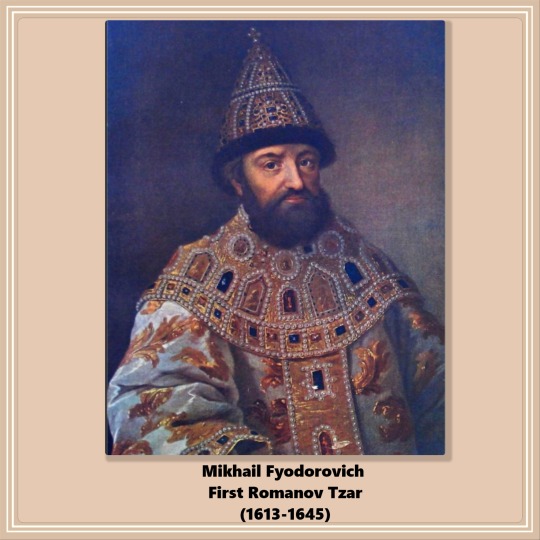






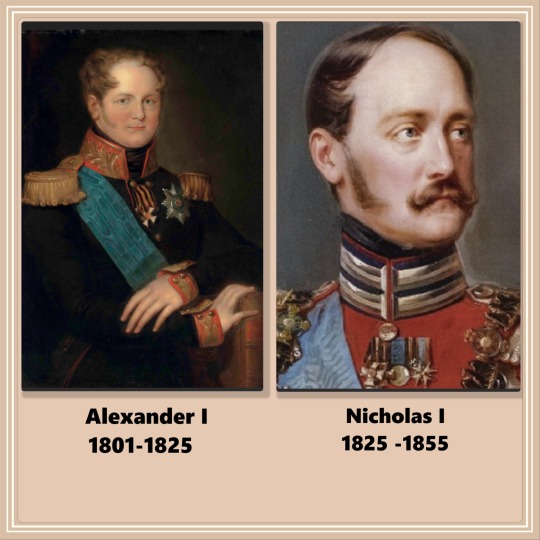

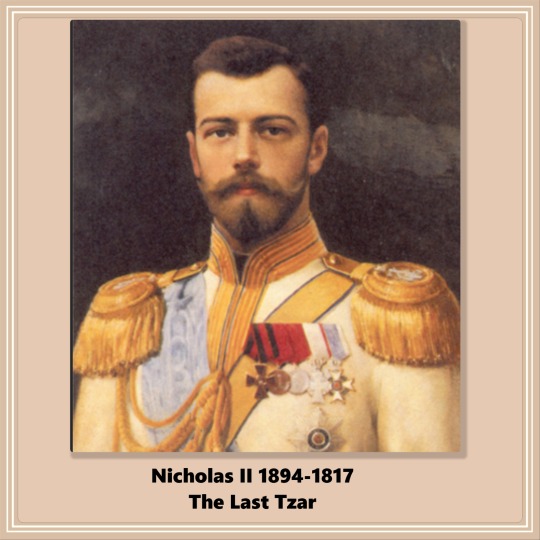
👑The Romanov Dynasty
The Grand Duchy of Moscow under Prince Ivan III was the first unified state on Russian territory. With him began the Rurikid Dynasty (the Rurikid had been around for a long time along hoards of tartars).
The Rurikid ruled from the 1400s until the 1600s. Ivan III can be considered the founder of Russia. While the Rurikid were in power, the Romanovs were boyars (nobles) in their courts. When the Ruriks became extinct, the Romanovs took over. The "Zemsky Sorbor" (a rudimentary parliament) elected Mikhail Feodorovich as the first Romanov Tzar.
The direct male line of the Romanovs ended with Elizabeth of Russia, who was childless. Her nephew Peter III, a member of the House of Holstein-Gottorp (a cadet branch of the German House of Oldenburg that reigned in Denmark), ascended to the throne and adopted his Romanov mother’s house name. Descendants after Elizabeth are sometimes referred to as "Holstein-Gottorp-Romanov."
The above is a gross oversimplification of a very complex course of events.
Highlights about each Romanov Tsar/Tsarina:
👑Mikhail Feodorovich (1613 - 1645): First Romanov Tsar
👑Alexei Mikhailovich (1645 - 1676): Encouraged trade and cooperation with Europe. Father of Peter the Great
👑Feodor III (1676 - 1682): Had very poor health and spent most of his reign in bed
👑Peter I and 👑 Ivan V (1689 - 1785): It was complicated. The two of them were Tsars under the regency of their older sister Sophia.
👑Peter I (1689-1725): Reformed Russia's politics, government, and culture. Made Russia a military power.
👑Catherine I (1725-1727): At the time of Peter the Great's death, the mechanism for succession consisted of the Tsar selecting his successor, but Peter did not elect one before dying. His wife became the Tsarina, but others governed through her.
👑Peter II (1727-1730): Peter's grandson; ascended the throne at 11 and died at 14. The "Privy Council" or "Soviet" ruled through him.
👑Anna Ioannovna (1730-1740): Daughter of Peter's half-brother Ivan. The Privy Council invited her to rule (wanting her to be a puppet), but she disbanded them and ruled herself successfully.
👑Ivan VI (1740-1741): One-year-old son of Ana's niece. She left the throne to him, expecting his mother to govern. Elizabeth, daughter of Peter the Great, deposed him (and his mother.)
👑Elizabeth Petrovna (1741-1761): Last Russian on the Russian throne; her twenty-year reign was successful.
👑Peter III (1761-1762): Grandson of Peter the Great and next in line for the throne after Elizabeth. Ruled for only half a year before being deposed by his wife, Catherine. He was murdered soon after the coup d’etat.
👑Catherine the Great (1762-1796): Her accomplishment went from the Empire’s territorial expansion to political development to the proliferation of sciences. However, the Empire had an enormous external debt by the end of her reign.
👑Paul I (1796-1801): Paul, the son of Catherine the Great and Peter III, became Emperor at 42 after the death of his mother. He started a lot of major military and political reforms. Paul was murdered in a coup d'etat. Paul decreed house laws for the Romanovs (the Pauline laws) – among the strictest in Europe – which established semi-Salic primogeniture and required Orthodox faith for the monarch and dynasts
👑Alexander I (1801-1825): During his reign, Russia defeated Napoleon's forces (which got as far as Moscow in their attempt to conquer Russia.) There was also great development in culture and arts.
👑Nicholas I (1825-1855): Paul I’s third son, younger brother of Alexander. Started railroad construction in Russia, boosting industrialization. Codified Russian laws and reformed finances.
👑Alexander II (1855-1881): His major reforms included the peasant emancipation of 1861, military reform, and the introduction of new types of self-governing village societies and more. Unfortunately, he fell victim to a terrorist after five attempts.
👑Alexander III (1881-1894): Russia didn’t enter any wars in his time. His domestic policy was conservative. He amended the Pauline laws. The economy flourished. But the revolution was brewing below the surface.
👑Nicholas II (1894-1917): His policies were unsuccessful. Established the first official Duma in 1905, but it was too little too late. With the advent of WWI, the Russian Empire ceased to exist. He abdicated. (gcl)
Sources:
Panov, A., Delaroche, P., & Abramuchkin, Y. (2021, July 31). The Complete List of Russian Tsars, Emperors, and Presidents. Russia Beyond. Retrieved June 20, 2023, from https://www.rbth.com/history/334065-complete-list-of-russian-tsars-emperors-rulers-presidents
#russian history#imperial russia#romanov dynasty#Nicholas II#Alexander III#Alexander II#Alexander I#Catherine I#Catherine II#Nicholas I#Paul III#Elizabeth Petrovna#Mikhail Feodorovich#Alexei Mikhailovich#Feodor III#Ivan VI#Peter I#Peter II#Peter III#Anna Ioannovna#Romanov Tsars#gcl
26 notes
·
View notes
Text
The Lost Grand Duchesses part 2: Alexandra Pavlovna
When she was born at 7:40 in the morning in 1783, the baby Grand Duchess Alexandra Pavlovna was instantly viewed as second class. Her grandmother, Catherine II ‘the Great’, wrote “I infinitely more like boys than girls”, and told her staff that she found the newborn to be very ugly. She called the baby “a very ugly creature.” This dislike of Alexandra continued into her toddler years, when Catherine continuously compared the young Alexandra to her baby sister, insisting that little Elena was much more charming and intelligent than Alexandra.
Despite this, Alexandra adored her grandmother, who wrote that the little girl would do “anything just to please me.” Alexandra and Elena were painted together as a gift to Catherine, and the two little girls lovingly hold up and caress a diamond encrusted miniature portrait of their grandmother.

By the age of four, Alexandra’s education had begun, and her intelligence in languages (being fluent in four) and writing made Catherine finally pay more attention to her, but for entirely different reasons.
As soon as the little girl turned eleven, Catherine wrote that the little girl who loved to dance, draw, and play music, was now to be “considered an adult”, and be made to marry. “It is time for the older one to get married” she concluded, not even mentioning Alexandra’s name.

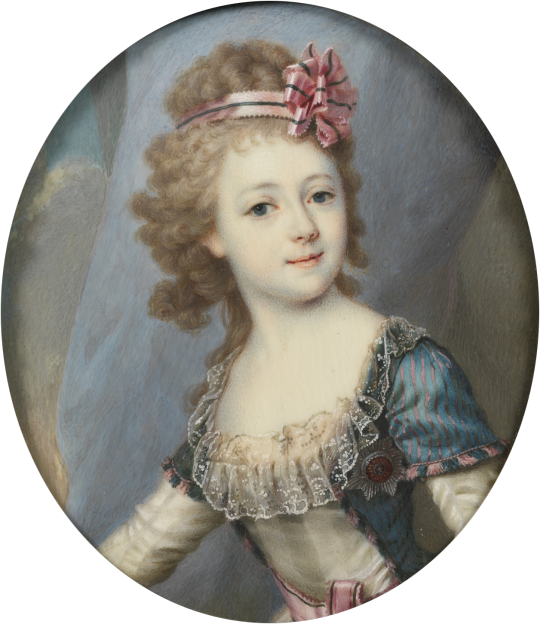
A long and embarassing debacle followed, in which the child was left at the alter. Catherine admitted that the young girl, not yet a teenager, often adopted a “confused look” when having to meet with potential husbands, and did not want to speak to them.
Catherine died in 1797, temporarily putting Alexandra’s fate in limbo. She returned to her daily life as an unmarried girl, and even published anonymous articles that she had translated in French under the pseudonym ‘A’. However, in 1799, the prospect of an Austrian-Russian alliance was apparently too attractive to pass on, and the thirty-year-old Archduke Joseph of Austria, the Palatine of Hungary, travelled to Russia to meet the thirteen-year-old Alexandra.
The marriage was finalised, and Alexandra was forced to leave Russia - and her family - in order to move to Hungary with her new husband. Joseph wrote a letter to his brother in which he stated he was “convinced that with this marriage my domestic bliss is assured for the entirety of my life.”
Alexandra, on the other hand, was miserable. Countess Varvara Golovina, a lady at court and potential lover of the Tsarina Elizaveta Alexeievna, wrote in her memoirs that Alexandra was sad, and did not want to be forced to leave Russia. Her father, Pavel I, constantly said that he would “not see her again” and that she was “being sacrificed.” Despite this, Pavel could have prevented the marriage at any time. A single lock of golden hair fashioned into a flower was all that she left behind.


Although Alexandra was popular in Hungary among all classes, she was deeply depressed. Her friendly and charming personality had been replaced by a new temperament which was “always serious and sad”. Alexandra especially did not get on well with her mother in law, the Empress Maria Theresa of Hungary, who was intensely jealous of the young girl’s popularity. Maria Theresa intentionally antagonised the teenager, and sought to treat her badly.
In 1800, Alexandra fell pregnant, and was struck with health problems. Her mother-in-law ordered the hiring incompetent doctors (known to her to be incompetent) and insisted that the doctors obey her orders, rather than present their own educated solutions. Orders from Maria Theresa included cooking meals which Alexandra would not be able to eat, making her weak and frail.
In March 1801, Alexandra gave birth to a little girl, named Alexandrine of Austria. The pregnancy and labour had been incredibly difficult, and the baby sadly passed away within a few hours of birth. Alexandra, depressed at having been forcibly taken from her home and after having to endure cruel treatment by her mother-in-law, said: “Thank God that my daughter was now with the angels, without experiencing the miser that we are exposed to.”
Alexandra contracted puerperal fever. The doctors misdiagnosed her poor health after the birth several times, treating her for gastric diseases and typhoid rather than ‘childbed’ fever. She succumbed to the disease aged just seventeen years old.
Alexandra was not buried until two years after her death due to disagreements in the Catholic Austrian court over where to bury a Russian Orthodox. In 1981, thieves broke into Alexandra’s Mausoleum, looting her coffin and taking jewellery and clothing from her remains. Due to the vandalism, she was reburied with the deceased wives and children of her husband in the crypt of Buda Castle, which went against her wishes to be buried in an Orthodox Church. In 2004, she was reburied at the Üröm Mausoleum, in a small park surrounded by a moat. Inside the tomb, Orthodox icons line the walls, a reflection of Alexandra’s beloved faith, and her deep connection with Russia, which endured even after being “sacrificed”.
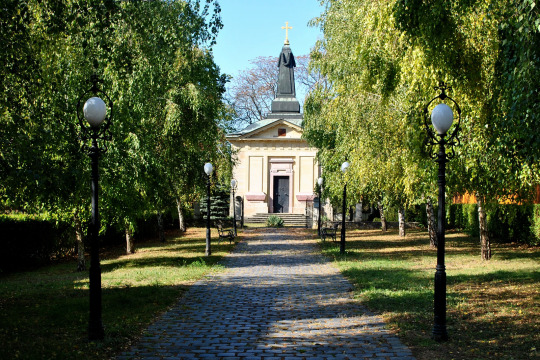
#the lost grand duchesses#alexandra pavlovna#what happened to her was so preventable#they just didn't love daughters enough to care#1700s#1800s#womens history#romanov#romanov family#russian history#hungarian history#pavel i#paul i#tsar paul#get the tissues out#justice for alexandra#the alexandra curse
14 notes
·
View notes
Text
Maybe an unpopular opinion but I wish they would finally stop only making movies and series of the tragic life of Sisi (Empress Elizabeth in Bavaria) and look for other interesting royal German/ Austrian or German speaking ladies/ queens like for example Queen Luise of Prussia (and her sister Charlotte, both being from the house of the dukes of Mecklenburg-Strelitz and having very interesting lifes) or Isabelle/ Elisabeth, called "Isabeau de Bavière" (from the House of Wittelsbach-Ingolstadt), wife of the so called mad French King Charles VI, mother of King Charles VII and Queen Catherine of England (first wife of Henry V of England, then married to Owen Tudor and mother of Henry VI).
Or St. Elizabeth of Thuringia/ Hungary who lived a life for the poor after she lost her husband, Ludwig/ Louis IV, the landgrave of Thuringia, in the 6th crusade (1227) and is among the most renowned Catholic saints.
I would also name Catherine the Great of Russia (Sophie of Anhalt-Zerbst) but there is a Russian series about her life and the one with Helen Mirren.
Then the famous St. Hildegard of Bingen, a famous and influential woman of the Middle Ages to this day in so many ways. Yes, there was a German movie about her some years ago but I don't think that it is widely known.
Then "Liselotte von der Pfalz" as Germans do call her, the Madame Palatine, wife of Philippe of Orlèans, brother of King Louis XIV aka the "sun king". She wrote a tremendous amont of letters in her life, leaving behind so much information about the court of the "sun king" that historians can only be thankful to her. Yes, there was the series "Versailles" but that wasn't quite an accurate one.
At least Maria Theresia of Austria, mother of Queen Marie Antoinette and King Joseph II got a series some years ago, cause let us face it, that woman was a great one. As a child it always impressed me wildly how many children she and Luise of Prussia got. It seemed insane to me.
With this I want to say: There is more good stuff about great German/ Austrian/ German speaking ladies out there. Wayyyy more.
And it angers me that it does not get depicted.
Only our tragic or as "weak/ bad" considered ladies do get some recognition like Sisi, Marie Antoinette or Tsarina Alice of Hesse. That is sad.
https://en.m.wikipedia.org/wiki/Isabeau_of_Bavaria
https://en.m.wikipedia.org/wiki/Elizabeth_of_Hungary
#the empress#elizabeth of austria#empress sisi#luise of prussia#charlotte of prussia#st. elizabeth of thuringia#st.elizabeth of hungary#isabeau de bavière#catherine the great
21 notes
·
View notes
Text
nine (9) people you'd like to know better
i was tagged!! thank you @kylesdubas
Last song: OK soooooooo im on the queer country train rn and broken horse by brandi carlile is the last song but before that it's a LOT of Lily Rose.
Currently watching: Not much tbh. youtube? i don't watch TV or movies too often. when i do i get obsessed so I'm careful when i watch.
Currently reading: The Tsarina's Lost Treasure: Catherine the Great, a Golden Age Masterpiece, and a Legendary Shipwreck by Gerald Easter and Mara Vorhees. and like five fanfics. I just finished all of the sidgeno exchange and that was wonderful
Current obsession: FUCKING WRITING LEGACY. (current word count: 31387) and finding more podfics to listen too.
Tagged? (if you want/haven't already been tagged!)
@dragonsthough101 @kudosonyou @heatherawoowoo @riahchan @flyingchiclets @robindrake13 @paintingtheice @plethoriall @ghostgeno
5 notes
·
View notes
Note
Hi Petrovna! what are your favourite tales about Romanovs?
Hi anon! Sorry for very very late reply. There are just a lot of things happening in my life and I have a lot of plans...
Honestly, talking about whole Romanov Dynasty, who are mentioned as nobles as early as 1366, and whose descendants are still pretenders to the throne, probably my favorite tale about them is life story of Tsarina Catherine I, wife of Peter the Great. I was lucky to come across a very good and in my opinion reliable book about this amazing woman, otherwise it would have been more difficult for me to know all those details. "Tsarina" by Elen Alpsten tells the story of Martha Skawronska, the illegitimate daughter of a poor peasant and a very young woman. Born in Livonia, a Baltic country where Latvians, Poles, Swedes, Russians and Germans were mixed, as she grows up, the Great Northern War will begin to rage. The unrecognized, poor and extremely pretty Martha is taken from her village and flees from town to town, until, by chance, she meets Peter, the Tsar of all the Russians. Driven by the desire for freedom and life, Martha will fall in love and the unknown villager will become the first independent woman, Tsarina, and the first Empress on the throne of the largest and most powerful Empire in the world. Catherine I.
Thank you for asking ;)
#romanov dynasty#catherine alexeevna#that woman also wrote a book about their daughter elizabeth#answered#anon ask
2 notes
·
View notes
Text


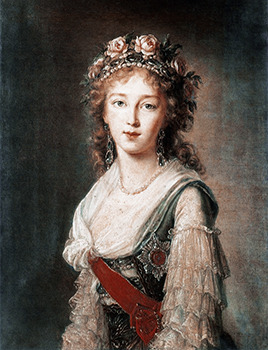
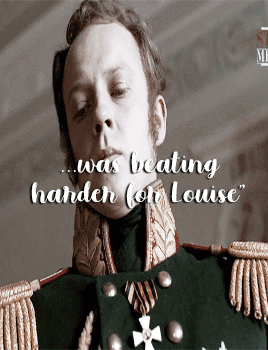
"Catherine would soon have the two sisters, Princesses Louise and Frederica of Baden, brought to court. As Maria Feodorovna, the wife of Paul I, would confide to Catherine, Alexander's heart was beating harder for Louise: "Alexander wrote to us that the delightful Louise pleases him more with each passing day; that there is in her a special beauty and humility that enchants him". Louise, in turn, wrote to her mother: "Grand Duke Alexander is very tall and well-built, he has above all a very well-formed leg and foot, although the foot is very large, but it is proportional to his height. He has light brown hair, blue eyes not too big, but not too small, beautiful teeth, charming skin, a straight nose, very beautiful. From the mouth, he very much resembles the Empress." The future defeatist of Napoleon liked to dress in white from head to toe. It was his habit to moisten his leather trousers to enhance the sculptural effect of his anatomy. As the ladies of the court said, "every part of his body could serve as a model for a sculptor.""
The Tsarinas - The Women who Made Russia | Vladimir Fedorovski.
(loose translation)
#tsar alexander i#facts#elizabeth alexeievna#tsarina elizabeth alexeievna#my own#the romanovs 2013#russian history#romanovs#tsar#tsarina#alexander and alizabeth#louise of baden#russian empire#history
125 notes
·
View notes
Note
Thank you for all of the great asks you’ve been sending out! I’m sending this one right back at you!
Which nations have treaties with each other? What are the conditions? How did these arrangements come about?
Of course! And thank you for the ask back <3
Within my own continent the most notable treaty/allaince is between Esha and Marseille.
The conditions of the treaty between them is mostly to protect human rights within their countries and secure trade. The two countries share a border with a large river that they both need travel through to trade around and outside the continent. The treaty is renewed with every generation of Kings. King Aviv III of Esha proposed the treaty to François IX d’Marcillac, Roi of Marseille, who accepted. Their heirs, King George III of Esha and Guillaume VIId’Marcillac, Roi of Marseille started the tradtion of renewing the contract every generation of heirs.
Esha and Chelyabinsk used to have a treaty together to also establish a safe trade route. To make the treaty concrete the two monarchs married their children together, King James I put forth the Grand Duchess Catherine, and Tsarina Vasilia I put forth her only son, Tsesarevich Alexey Nikolaevich. The two only had one child together and the treaty only lasted until their great great grand child passed away. By that point the two countries despised each other.
Chelyabinsk and Reka have a treaty between the now Oligarchy of Chelyabinsk and the Imperial Family of Reka.
Tridendro and the United Republic of Narkos have a treaty for safe trade routes as well.
Catalia and Dörnberg have no current treaties.
4 notes
·
View notes
Photo








Royal Birthdays for today, June 6th:
Catherine Vasa, Countess of East Frisia, 1539
Joseph I, King of Portugal, 1714
Maria Theresa of Naples of Sicily, Holy Roman Empress and Empress of Austria, 1772
Thieu Tri, Emperor of Vietnam, 1807
Alexandra Feodorovna, Tsarina of Russia, 1872
Albert II, King of Belgium, 1932
Dom Luiz, Prince of Orléans-Braganza, 1938
Ashi Euphelma Choden Wangchuck, Princess of Bhutan, 1993
#catherine vasa#joseph i#Alexandra Feodorovna#maria theresa of naples and sicily#albert ii#dom luiz#Ashi Euphelma Choden Wangchuck#Thieu Tri#long live the queue#royal birthdays
19 notes
·
View notes
Text
A Short History of the Palace
The Alexander Palace was ordered by Catherine the Great for her grandson, the future Alexander I. She began to plan for the building when he was quite young and intended to present it to him when he became an adult. She enjoyed discussing his future palace with the young Alexander and invited him to draft his own ideas for it.
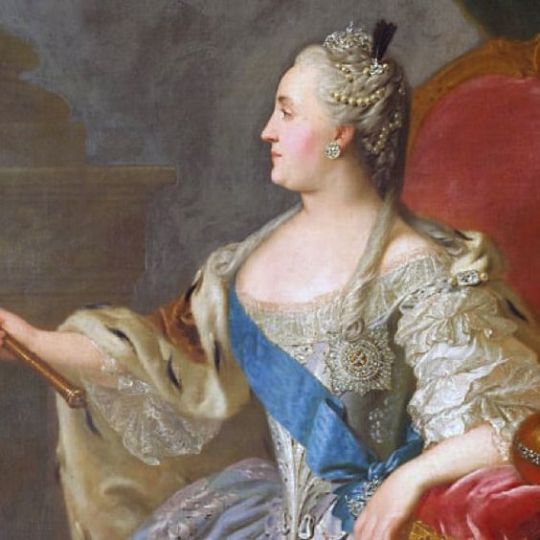

Giacomo Quarenghi was the architect of the palace. He was born in Bergamo, Italy in 1744 and died in St. Petersburg in 1817. Quarenghi came from a family of artists. He was originally trained as a painter and had exceptional drawing abilities. He travelled throughout Italy, England and France studying architecture. Quarenghi had been deeply influenced by the Palladian style he saw in his native region around Venice during his youth. He was also impressed by the latest trends in Neo-classical architecture being built in France and the earlier, chaste designs of the English architect, Indigo Jones. Catherine invited Quarenghi to Russia in 1779, when he was thirty.
Physically Quarenghi was short and ugly. He was ridiculed by his critics for his height and appearance. He was clumsy and had a strange booming voice. Quarenghi had 13 children, some of whom lived in Russia and others who stayed in Italy.
Immediately upon his arrival in Russia the Tsarina put Quarenghi to work and commissioned many designs from him throughout her reign. He was one of her favorite architects. He was a master draughtsman and produced splendid sepia plans for the palace for Catherine which still survive.
Originally the Alexander Palace was planned for St. Petersburg. The first designs, (above) which were intended for an urban environment, clearly show a more ornate facade and a complex interior plan. At some point Catherine decided to build Alexander's palace in Tsarskoe Selo and simplify the plan. These changes went through several stages as plans for the palace neared reality.
Catherine selected a spot near her own residence in the Catherine Palace for the building. The site was a low hill on the other side of the palace park. Moving the location of the palace from the city to Tsarskoe Selo changed many of design requirements for the building. In Petersburg the palace had been designed a year-round Imperial residence; in Tsarskoe Selo the palace would function as a summer home, to be used only a few months out of the year. These circumstances reduced the need for expensive interiors and embellishments intended to impress the public. The palace plans were also modified to fit the more relaxed atmosphere of a summer residence.


Following the practice of the times, in 1792 the Imperial Court placed an advertisement in the St. Petersburg newspapers requesting bids from private contractors to build the palace. The selected firm was placed under the supervision of the Russian architect Nilov, who had been given the assignment of translating Quarenghi's designs into reality. He worked with Minchacci, Rusco and others. 286,000 rubles was paid to the contractor in installments which was to be fully paid by autumn of 1794. The building of the palace presented a number of challenges related to the site. Underground rivers which passed beneath the surface of the site caused the building to shift as it was going up. Major cracks developed in the main vault of the Semi-Circular Hall which can still be seen today. The builders made a number of on-the-spot changes to the design to accommodate problems like this that emerged during construction. A large terrace was built outside the garden entrance of the building to support and reinforce the vaults of the central halls. The contractors who put up the building had made a fixed bid for the construction. Delays and increased building costs came out of potential profits and they were anxious to put up the building as quickly and with as few complications as possible.
The palace foundations are of stone, but elsewhere the Alexander Palace is almost entirely constructed of brick. Millions were required to build the palace and they were made in the immediate vicinity of the of Tsarskoe Selo from local clays. This was a subject of some concern for Catherine. She strictly ordered the protection of local forests for fear the builders would strip the trees around Tsarskoe Selo to fire their kilns and possibly ruin her vistas.
The original bid for the construction of the building did not include funds for the interior decoration. The firm constructing the building did not have responsibility for the interiors and this assignment was given to an international team of British, Russian and Italian craftsmen. But as the construction of the building progressed Catherine found herself pressed for funds, and continued scaling back the interior decoration of the palace. This was not seen as a serious problem, the Empress felt Alexander could make his own additions later according to his own tastes.
Some furniture for the palace was ordered new, but most of it was assembled from other palaces. For example, a number of things were brought from the seldom-used Tauride Palace. Catherine made other selections for Alexander's palaces from her own residences.
At first, the exterior of the palace was left as exposed brick. It took a number of years for the brickwork to dry out and final stuccoing and painting could not safely occur for some years. The "New Palace", as it was then called, was completed and presented to Alexander in June 1796. He and his wife moved in on June 12, 1796. The construction had taken almost four years. Catherine greeted the then sixteen-year-old boy and his new wife, Elizabeth of Baden, on the steps of the palace with bread and salt, traditional gifts of blessing for a new house. Alexander had but a short time to enjoy the palace before the death of his grandmother in November of the same year. This event significantly changed the circumstances of his life and he came under the control of his father, the new Emperor Paul I.
During Paul's reign the palace was stuccoed and painted. It seems that the building was painted yellow and white from the beginning, although the original color was deeper and more intense that the hue we see today.
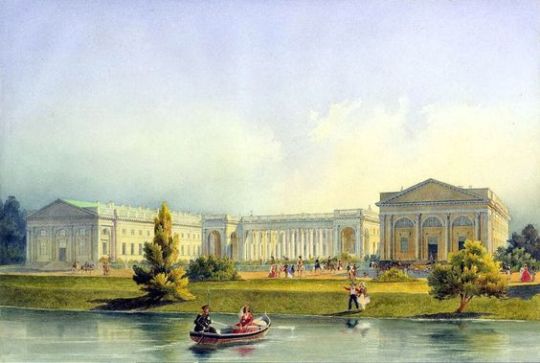
Paul was unpopular with a wide segment of society and was assassinated in the Mikhailovski Castle in St. Petersburg. Some claim Alexander was implicated in the murder, who then succeeded his father on the Russian throne. During his reign Alexander preferred to live in the Catherine Palace over the Alexander Palace when he was in Tsarskoe Selo. This does not mean he neglected the Alexander Palace, which required a great deal of maintenance in this period. In 1809 600,000 rubles had to be allocated for repairs to the building and the building's contents were fully inventoried for the first time.
Alexander and his wife were childless and he decided to designate his second brother, the future Nickolas I, to succeed him. He offered the Alexander Palace to Nickolas and began the tradition of making the Alexander Palace the Heir's semi-official summer palace in Tsarskoe Selo.
The palace retains the indelible mark of Nicholas I and his times. Nicholas had a large and growing family. Although he has a reputation for being a harsh ruler, when outside of governmental affairs he was a sentimental, family oriented man. The Alexander Palace was his favorite residence and he doted on the building, its furnishings and grounds. Many of the changes made to the palace reflect Nicholas' attitude toward the palace as his private home. For example he had special kitchens built within he palace so he could order favorite fast foods when he wanted them. He even did some of the cooking himself. Nicholas personally planted flower beds and made the final decision regarding the placement of each painting and piece of furniture. After becoming Tsar Nicholas' continued to favor the Alexander Palace and stayed there often.
Nicholas chose the Alexander Palace for some of the important events of his reign, including the first telegraph transmission in Russia, which the Tsar made from the palace.
Following in the footsteps of his elder brother, Nicholas gave the use of the Alexander Palace to his eldest son and heir, the future Alexander II, on the occasion of his marriage. This lead to a complete redecoration and updating of the palace. Technical advancements in lighting, heating and cooking meant changes went beyond simply new fabrics, furniture and carpets. The palace was completely modernized and brought up-to-date in the mid 1840's. Later in life, after her husband had become Tsar and taken on a mistress, Alexander's wife, the Hessian Princess Maria Alexandrovna, decided to live in the Alexander Palace year-round. This presented problems because the palace had been built as a summer residence. It lacked the double-paned windows and double floors necessary to keep a building warm during frigid Russian winters. New heating systems were installed in the parts of the palace occupied by the Tsarina.
As Tsarevich the future Tsar Alexander III and his wife Maria were presented the use of the Alexander Palace at their marriage by his father. His mother continued to live in the palace and Alexander's use of it was limited until her death in the palace. In 1874 a part of the palace was remodelled for the honeymoon of Alexander II's only daughter, Maria, to Alfred, the son of Queen Victoria of England.
Alexander III's wife Maria Fyodorovna loved the Alexander Palace passionately. She adored the parties and elegance of Tsarskoe Selo over the austerity of her husband's own preference, Gatchina. Two of Maria and Alexander's sons, the future Nicholas II and his brother George, were born in the palace. As they grew older both boys continued to have apartments in the palace and used them whenever they were in Tsarskoe Selo.
When Nicholas ascended the throne in 1894 he and his new wife Alexandra decided to make the Alexander Palace their principal residence. As a result, Nicholas II and his wife made the most significant changes to the building since the reign of Catherine the Great. Extensive renovations were made to the building and new systems, such as electricity, telephones, washing machines, elevators and flush toilets, were installed. One whole wing of the palace was completely redone in a strikingly domestic and luxurious way. Nicholas and Alexandra's principal objectives were to create a comfortable and elegant family home.
Later changes to the palace in the reign of Nicholas II included the erection of the two finest Imperial Art Nouveau interiors in Russia and delightful rooms created for the Tsar's children.
At the time of the Russian Revolution and the exile of the Romanov family to Siberia it was decided to convert the Tsar's palace into a museum which documented the life of the Romanovs in the palace throughout the 19th century . Naturally, the strongest emphasis was placed on events in the reign of Nicholas II. Soon after the departure of the Romanovs for Tobolsk in August 1917 parts of the palace were opened to the public by it's first curator, Lukomskii. After the murder of the Romanovs in Yekaterinburg in July 1918 some of their personal possessions that hand followed them to Siberia were returned.
The museum in the Alexander Palace showcased the interiors as closely as possible to their state in August 1917. They appeared as if the Tsar and his family had just left and might return at any moment. The tragedy of the story of the Romanovs and the intimacy of the private rooms created a lasting impression on those who saw them, creating sympathy for the Tsar and his family and this ran counter to the intentions of the Soviet Government. In 1919, soon after the Bolshevik coup, a part of the palace was converted into a Children's Colony, but this experiment proved to be a disaster and these rooms were returned to the museum. Extensive restoration enabled these rooms to be reopened to the public. In the mid-1920's Nicholas' and Alexandra's historic rooms in the Winter Place, which had been open as a part of the museum there, were closed and their furnishings disbursed. Some items were transferred to the rooms of the Alexander Palace where they were merged into the collection.
The Alexander Palace museum proved to be one of the most popular museums in Russia and was a must see for all foreigners who made it to the new Soviet state. Unfortunately, the government had an indifferent, even hostile attitude toward the "Romanov Museum". Officials began to pilfer objects and furnishings from the palace for sale to foreigners and for the use of party officials. Later the secret police demanded the use of a part of the palace as their private resort. In order to prepare for this transition these rooms were emptied of their contents and the treasures sold off in stores for foreigners in Russia and by Hammer in the USA.
Throughout the 1930's there were frequent threats by the government to close the rest of the museum and sell off its treasures. Somehow, the museum workers and public managed to dissuade the government from this step and the museum operated right up until the beginning of World War II.
At the outset of Hitler's declaration of war on the Soviet Union in 1941 the Director of the Alexander Palace Museum, A. M. Kuchumov, received orders to evacuate around 300 objects from the path of advancing German troops. This was a tiny selection from a collection totalling tens of thousands of objects. Frantically, and with great courage and improvisation, the museum workers were able to pack and ship out of harm's way a significant part of the museums' collection. Sadly, thousands of precious treasures and items of extraordinary historical value were left behind.
When the Germans occupied the town they immediately looted the palaces. What they didn't cart away for use in their military quarters was shipped off to Germany and Spain, where many of the palace treasures remain to this day. The palace itself was converted into an SS hospital and was heavily protected by German troops. An SS monument and graveyard decorated with Nazi symbols was erected in the palace courtyard. The palace was heavily damaged during the war by shell fire and reckless abuse by the Germans and their Spanish allies during their occupation.
Still, considering the ordeal it had been through after the war the palace was discovered by returning museum workers to be in remarkable shape. It was the best preserved of all of the suburban palaces that had been behind German lines and was chosen to become the depot for works of art returning from Siberia to Leningrad. Ambitious plans were made for the restoration of the palace as it had been before the war. At this point the government, perhaps Stalin himself, made a critical decision about the future of the palace - it was not to be a Romanov museum. The palace was to be stripped and restored as a generic 19th century palace - any restoration that presented the private lives of the last Tsar and his family were forbidden. This restoration began and interiors which had survived the German occupation were brutally stripped and destroyed. Before this work was completed Stalin changed his mind and made another decision that the museum was to be closed altogether and the building presented to the Navy for their use.
The invaluable and unique collection of the palace was dispersed among many museums. Pieces went to Pavlovsk, the Catherine Palace, the Hermitage and elsewhere. Most personal items associated with the last Tsar and his family were simply locked up and placed in indefinite storage.
In the late 1980's Suzanne Massie and Bob Atchison, with the blessing of the former curator of the Alexander Palace, A. M. Kuchumov, who had made the restoration of the palace as a museum his life's goal, appealed to the press and the city of Leningrad for the reestablishment the Alexander Palace Museum. This intense and exhausting effort proved successful and a government decision was made to re-establish the museum. The only stipulation was the successful relocation of the naval institution occupying the building to an acceptable location.
Work continued to make the museum a reality. Several years of research on the palace under the direction of Kuchumov were financed by Bob Atchison. In 1994 the Alexander Palace website was established to help promote interest in the monument. The results of the research are shared with the public for free on the website.
3 notes
·
View notes
Text
today i offer you cleo, lizzie, marie, cath, vicky and alex. tomorrow? probably nothing.
this redraw took me 3 hours appreciate it >:)

oh and this is the old version 🤢🤢🤢🤢
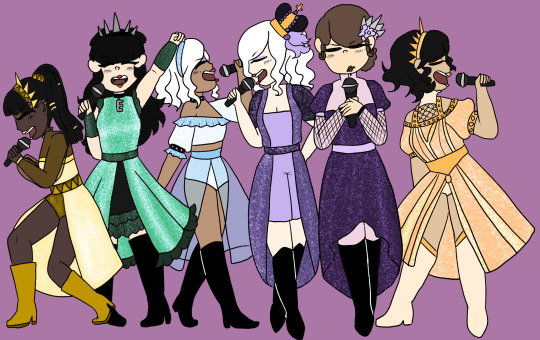
#digital art#art#six the musical#elizabeth i#six the musical art#catherine the great#queen victoria of england#queen victoria#empress alexandra#tsarina alexandra#cleopatra#elizabeth i of england#elizabeth tudor#marie antoinette#queen marie antoinette#empress catherine#empress catherine of russia
28 notes
·
View notes
